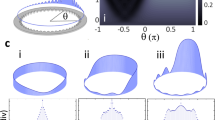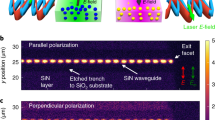Abstract
Nonlinearity in complex systems leads to pattern formation through fundamental interactions between components. With integrated photonics, precision control of nonlinearity explores novel patterns and propels applications. In particular, Kerr-nonlinear resonators support stationary states—including Turing patterns—composed of a few interfering waves, and localized solitons composed of waves across a broad spectrum. Although Turing patterns emerge from an unstable Kerr resonator with sufficiently intense excitation, Kerr solitons do not form spontaneously under constant excitation, making this useful state challenging to access. Here we explore an edgeless photonic crystal resonator (PhCR) that enables spontaneous soliton formation in place of Turing patterns. We design the PhCR nanopattern for single-azimuthal-mode engineering of a group-velocity-dispersion defect that balances Kerr-nonlinear frequency shifts in favour of the soliton state. Our experiments establish PhCR solitons as modelocked pulses through ultraprecise optical-frequency measurements. We show that nanophotonics expand the palette for nonlinear engineering, enabling new phenomena and light sources.
This is a preview of subscription content, access via your institution
Access options
Access Nature and 54 other Nature Portfolio journals
Get Nature+, our best-value online-access subscription
$29.99 / 30 days
cancel any time
Subscribe to this journal
Receive 12 print issues and online access
$209.00 per year
only $17.42 per issue
Buy this article
- Purchase on Springer Link
- Instant access to full article PDF
Prices may be subject to local taxes which are calculated during checkout




Similar content being viewed by others
Data availability
The data that support the findings of this study are available from the corresponding author on reasonable request.
Code availability
The simulation codes used in this study are available from the corresponding author on reasonable request.
References
Hickstein, D. D. et al. High-harmonic generation in periodically poled waveguides. Optica 4, 1538–1544 (2017).
Tadanagaa, O. et al. Efficient 3-m difference frequency generation using direct-bonded quasi-phase-matched LiNbO3 ridge waveguides. Appl. Phys. Lett. 88, 061101 (2006).
Carr, L. D. & Brand, J. Spontaneous soliton formation and modulational instability in Bose–Einstein condensates. Phys. Rev. Lett. 92, 040401 (2004).
Parteli, E. J. R., Andrade, J. S. Jr & Herrmann, H. J. Transverse instability of dunes. Phys. Rev. Lett. 107, 188001 (2011).
Godey, C., Balakireva, I. V., Coillet, A. & Chembo, Y. K. Stability analysis of the spatiotemporal Lugiato–Lefever model for Kerr optical frequency combs in the anomalous and normal dispersion regimes. Phys. Rev. A 89, 063814 (2014).
Qi, Z. et al. Dissipative cnoidal waves (turing rolls) and the soliton limit in microring resonators. Optica 6, 1220–1232 (2019).
Kippenberg, T. J., Gaeta, A. L., Lipson, M. & Gorodetsky, M. L. Dissipative Kerr solitons in optical microresonators. Science 361, eaan8083 (2018).
Marin-Palomo, P. et al. Microresonator-based solitons for massively parallel coherent optical communications. Nature 546, 274–279 (2017).
Fülöp, A. et al. High-order coherent communications using mode-locked dark-pulse Kerr combs from microresonators. Nat. Commun. 9, 1598 (2018).
Suh, M.-G., Yang, Q.-F., Yang, K. Y., Yi, X. & Vahala, K. J. Microresonator soliton dual-comb spectroscopy. Science 354, 600–603 (2016).
Trocha, P. et al. Ultrafast optical ranging using microresonator soliton frequency combs. Science 359, 887–891 (2018).
Yu, S.-P. et al. Tuning Kerr-soliton frequency combs to atomic resonances. Phys. Rev. Appl. 11, 044017 (2019).
Kordts, A., Pfeiffer, M. H. P., Guo, H., Brasch, V. & Kippenberg, T. J. Higher order mode suppression in high-Q anomalous dispersion sin microresonators for temporal dissipative Kerr soliton formation. Opt. Lett. 41, 452–455 (2016).
Lobanov, V., Lihachev, G., Kippenberg, T. J. & Gorodetsky, M. Frequency combs and platicons in optical microresonators with normal GVD. Opt. Exp. 23, 7713–7721 (2015).
Xue, X. et al. Mode-locked dark pulse Kerr combs in normal-dispersion microresonators. Nat. Photon. 9, 594–600 (2015).
Kocaman, S. et al. Zero phase delay in negative-refractive-index photonic crystal superlattices. Nat. Photon. 5, 499–505 (2011).
Miura, R. et al. Ultralow mode-volume photonic crystal nanobeam cavities for high-efficiency coupling to individual carbon nanotube emitters. Nat. Commun. 5, 5580 (2014).
Fang, K., Matheny, M. H., Luan, X. & Painter, O. Optical transduction and routing of microwave phonons in cavity-optomechanical circuits. Nat. Photon. 10, 489–496 (2016).
Petrovich, M. N., Poletti, F., van Brakel, A. & Richardson, D. J. Robustly single mode hollow core photonic bandgap fiber. Opt. Exp. 16, 6 (2008).
Sharma, M., Konar, S. & Khan, K. R. Supercontinuum generation in highly nonlinear hexagonal photonic crystal fiber at very low power. J. Nanophoton. 9, 093073 (2015).
Hu, S. & Weiss, S. M. Design of photonic crystal cavities for extreme light concentration. ACS Photon. 3, 1647–1653 (2016).
Kim, S. et al. Dispersion engineering and frequency comb generation in thin silicon nitride concentric microresonators. Nat. Commun. 8, 372 (2017).
Moille, G., Li, Q., Kim, S., Westly, D. & Srinivasan, K. Phased-locked two-color single soliton microcombs in dispersion-engineered Si3N4 resonators. Opt. Lett. 43, 2772–2775 (2018).
McGarvey-Lechable, K. et al. Slow light in mass-produced, dispersion-engineered photonic crystal ring resonators. Opt. Exp. 25, 3916–3926 (2017).
Lu, X., Rogers, S., Jiang, W. C. & Lin, Q. Selective engineering of cavity resonance for frequency matching in optical parametric processes. Appl. Phys. Lett. 105, 151104 (2014).
Joannopoulos, J., Villeneuve, P. R. & Fan, S. Photonic crystals: putting a new twist on light. Nature 386, 143–149 (1997).
McGarvey-Lechable, K. & Bianucci, P. Maximizing slow-light enhancement in one-dimensional photonic crystal ring resonators. Opt. Exp. 22, 26032–26041 (2014).
Herr, T., Gorodetsky, M. L. & Kippenberg, T. J. Dissipative Kerr solitons in optical microresonators. In Nonlinear Optical Cavity Dynamics: From Microresonators to Fiber Lasers Ch. 6 (Wiley-VCH Verlag GmbH, 2015).
Jung, H. et al. Kerr solitons with tantala ring resonators. In Proceedings to Nonlinear Optics Conference—OSA Technical Digest NW2A.3 (The Optical Society, 2019).
Stone, J. R. et al. Thermal and nonlinear dissipative-soliton dynamics in Kerr-microresonator frequency combs. Phys. Rev. Lett. 24, 063902 (2018).
Brasch, V., Geiselmann, M., Pfeiffer, M. H. P. & Kippenberg, T. J. Bringing short-lived dissipative Kerr soliton states in microresonators into a steady state. Opt. Exp. 24, 29312–29320 (2016).
Guo, H. et al. Universal dynamics and deterministic switching of dissipative Kerr solitons in optical microresonators. Nat. Phys. 13, 94–102 (2017).
Briles, T. C. et al. Interlocking Kerr-microresonator frequency combs for microwave to optical synthesis. Opt. Lett. 43, 2933–2936 (2018).
Drake, T. E. et al. Terahertz-rate Kerr-microresonator optical clockwork. Phys. Rev. X 9, 031023 (2019).
Drake, T. E., Stone, J. R., Briles, T. C. & Papp, S. B. Thermal decoherence and laser cooling of Kerr microresonator solitons. Nat. Photon. 14, 480–485 (2020).
Matsko, A. B., Liang, W., Savchenkov, A. A., Eliyahu, D. & Maleki, L. Optical Cherenkov radiation in overmoded microresonators. Opt. Lett. 41, 2907–2910 (2016).
Cole, D. C., Lamb, E. S., Del’Haye, P., Diddams, S. A. & Papp, S. B. Soliton crystals in Kerr resonators. Nat. Photon. 11, 671–676 (2017).
Shen, B. et al. Integrated turnkey soliton microcombs. Nature 582, 365–369 (2020).
Bino, L. D. et al. Microresonator isolators and circulators based on the intrinsic nonreciprocity of the Kerr effect. Optica 5, 279–282 (2018).
Balram, K. C. et al. The nanolithography toolbox. J. Res. Natl Inst. Stand. Technol. 121, 464–475 (2016).
Bao, C. & Yang, C. Mode-pulling and phase-matching in broadband Kerr frequency comb generation. J. Opt. Soc. Am. B 31, 3074–3080 (2014).
Acknowledgements
Funding was provided by the DARPA DODOS (all authors), and DRINQS and PIPES programmes (S.-P.Y., D.C.C., H.J., S.B.P.). We acknowledge the Boulder Microfabrication Facility, where the devices were fabricated. We thank T. Briles and J. Chiles for a careful reading of the manuscript. This work is a contribution of the US Government and is not subject to copyright. Mention of specific companies or trade names is for scientific communication only, and does not constitute an endorsement by NIST.
Author information
Authors and Affiliations
Contributions
S.-P.Y. contributed in the conception, design and fabrication, and performed the optical measurements and theoretical analysis. D.C.C. developed the simulation software and contributed to the theoretical understanding. H.J. initiated the development of the tantala material platform. G.T.M. provided discussions helpful to the conception. K.S. provided input on theory and fabrication development. S.B.P. contributed to the theoretical understanding and supervised the findings of this work. All authors provided feedback and helped shape the research, analysis and manuscript.
Corresponding author
Ethics declarations
Competing interests
The authors declare no competing interests.
Additional information
Peer review information Nature Photonics thanks Maxim Shcherbakov, Yun-Feng Xiao and the other, anonymous, reviewer(s) for their contribution to the peer review of this work.
Publisher’s note Springer Nature remains neutral with regard to jurisdictional claims in published maps and institutional affiliations.
Supplementary information
Supplementary Information
Supplementary Figs. 1–3 and discussion.
Rights and permissions
About this article
Cite this article
Yu, SP., Cole, D.C., Jung, H. et al. Spontaneous pulse formation in edgeless photonic crystal resonators. Nat. Photonics 15, 461–467 (2021). https://doi.org/10.1038/s41566-021-00800-3
Received:
Accepted:
Published:
Issue Date:
DOI: https://doi.org/10.1038/s41566-021-00800-3
This article is cited by
-
Strong interactions between solitons and background light in Brillouin-Kerr microcombs
Nature Communications (2024)
-
Synthetic reflection self-injection-locked microcombs
Nature Photonics (2024)
-
Integrated vortex soliton microcombs
Nature Photonics (2024)
-
Wavelength-accurate nonlinear conversion through wavenumber selectivity in photonic crystal resonators
Nature Photonics (2024)
-
Tailoring microcombs with inverse-designed, meta-dispersion microresonators
Nature Photonics (2023)



